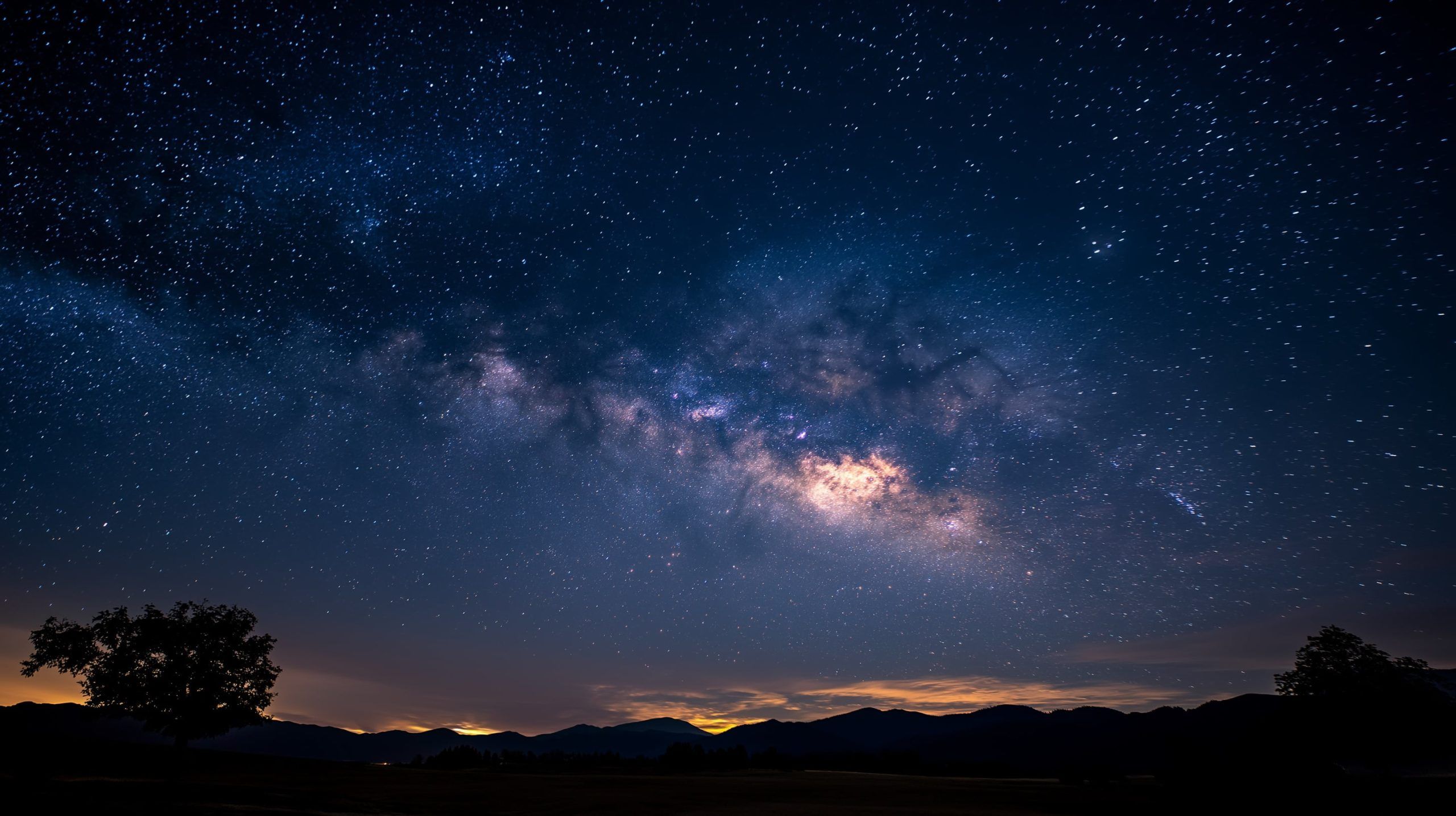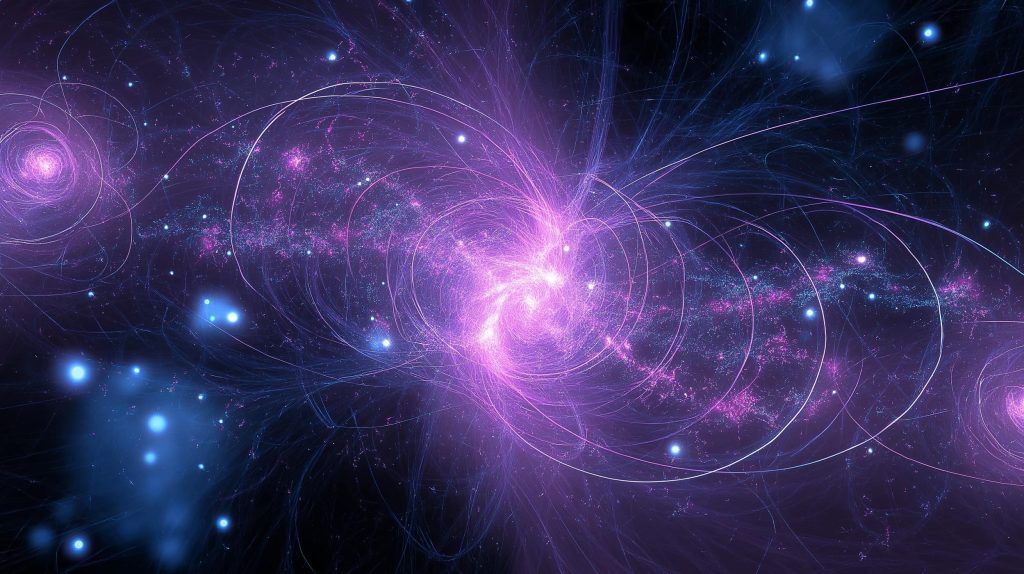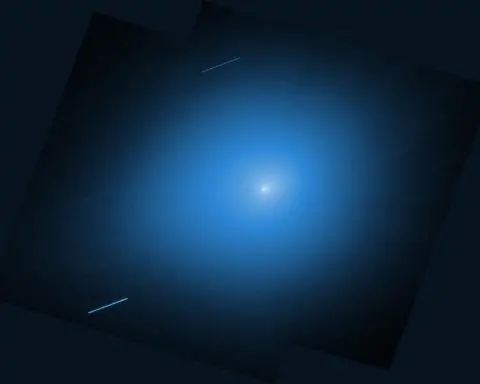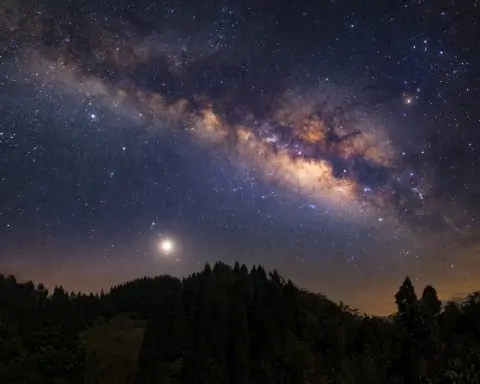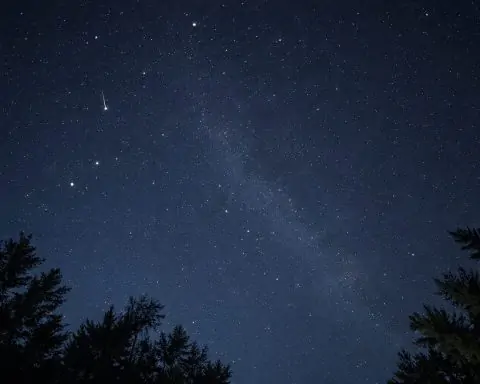- The Perseid meteor shower is already ramping up for Aug 5–6, 2025, with an expected 10–20 meteors per hour under dark skies after midnight.
- Perseids are famous for fireballs, producing bright meteors that can blaze through moonlight despite lunar glare.
- The full Sturgeon Moon occurs on Aug 9, and the peak nights Aug 11–13 will have 84–90% moonlight, washing out dimmer meteors.
- Venus and Jupiter form a dawn pair before sunrise on Aug 5–6, with Venus at magnitude -4.0 and Jupiter at about -1.9, about 7–8° apart.
- The Venus–Jupiter pair will reach its closest approach around Aug 11–12, when they’re about 1° apart.
- Saturn rises around 10:30 p.m. local time in early August and shines around magnitude 0.8 by midnight, with its rings tilted for good viewing.
- On Aug 6, Saturn and Neptune make a rare conjunction in the sky, with Neptune at magnitude ~7.8 and both visible in the same low-power field of view with a telescope.
- Mars is visible in evening twilight at around magnitude +1.6 in Virgo, fading and setting shortly after dark, and may require binoculars for a better view.
- Mercury is not visible on Aug 5–6, sitting near superior conjunction and hidden in solar glare, with re-emergence in mid‑August and best morning viewing in late August.
- The ISS will offer visible passes around Aug 4–6 in the early-to-mid evening for many mid-northern locations, with brightness up to magnitude −3 and a sky-crossing time of 3–6 minutes.
Get ready for a cosmic show on the nights of August 5–6, 2025. From a ramping-up meteor shower to a dazzling double-planet dawn display, the sky has something for everyone. Around the globe, stargazers can look forward to Perseid meteors streaking across the late-night sky, Venus and Jupiter shining side-by-side before sunrise, an almost-full “Sturgeon Moon” lighting the night, and even the ISS space station gliding overhead. Here’s your complete guide to all the celestial highlights (and how to see them) on these dates.
Perseid Meteor Shower Ramps Up (Despite Moonlight)
The Perseid meteor shower – one of the most anticipated sky events each August – is already active and building toward its mid-month peak. Astronomer Don Pollacco describes the Perseids as “bright blue meteors — and lots of them,” with up to around 100 shooting stars per hour under ideal dark skies [1] [2]. In fact, NASA calls the Perseids “the best meteor shower of the year” for their abundance of fast, vivid meteors [3]. 2025, however, isn’t ideal for Perseid watchers – a bright Moon will interfere during the peak. The full Sturgeon Moon on August 9 means the peak nights (Aug 11–13) will have 84–90% moonlight “brightening the sky and washing out the dimmer meteors,” experts warn [4]. The American Meteor Society notes that the bright Moon will “severely compromise” Perseid counts at maximum, with only the brightest fireballs visible [5] [6]. The good news is the Perseids are famous for fireballs – big, bright meteors that can punch through the moonlight. “The Perseids result from bigger particles than a lot of other showers,” explains Bill Cooke of NASA’s Meteoroid Environment Office, which means more “bright fireballs” that still stand out despite the Moon [7]. So even if many faint meteors are lost in the moon glow, a few spectacular Perseid fireballs could still blaze across the sky [8].
What to expect on Aug 5–6: We’re about a week before the Perseids’ peak, and the shower is already ramping up. As EarthSky puts it, we’ve “entered the Perseid meteor stream,” meaning you might catch Perseids “anytime now” in early August [9]. In fact, overall meteor activity kicks into high gear in August – not just from Perseids but also from random “sporadic” meteors, which roughly double their springtime background rates around now [10] [11]. If you head out after midnight until dawn on Aug 5–6, you could see on the order of 10–20 meteors per hour under dark skies [12] [13]. That count is a mix of early Perseids plus other stray shooting stars. The Moon will be a waxing gibbous (~85–95% full) on these nights, rising in the late afternoon and setting in the very early morning hours [14]. This actually helps dedicated meteor-watchers: there will be a window of darker sky just before dawn, after the Moon sets, which is prime time for meteor spotting [15]. The pre-dawn hours are typically best for meteors anyway, as the side of Earth you’re on is plowing headfirst into the meteor stream then [16]. Plan to watch in the wee hours before sunrise on Aug 5 or 6 for your best chance to catch a few “shooting stars” [17].
Other minor meteor showers are also contributing a trickle of meteors. The Southern Delta Aquariids (which peaked in late July) are tapering off; at peak they produce ~10–20 meteors/hour [18], but by early August they’ll add only a few faint meteors, mostly seen from the Southern Hemisphere or low northern latitudes [19]. Another minor shower, the Alpha Capricornids (peaked around July 29), is sparse in number but famous for slow, bright fireballs. You might spot the occasional Capricornid fireball in the first week of August – distinguishable by its slow speed and yellowish glow compared to the faster Perseids [20]. In short, summer nights are rich with meteors from multiple sources. Even before the Perseid peak arrives, don’t be surprised if you catch a random streak of light or two. And if 2025’s Perseid display is a bit muted by moonlight, take heart: next year (2026) the Perseids peak under a new moon for an truly stellar show [21]!
Meteor viewing tips: To maximize your meteor count, get to a dark location away from city lights and be patient. Plan for after local midnight (once Perseus, the shower’s radiant constellation, climbs higher) until dawn for the best rates [22] [23]. If the Moon is still up, position yourself facing away from it or use trees or a building to block the glare [24]. Lie back, give your eyes ~30 minutes to adjust to the dark, and just watch the sky – no telescopes or binoculars needed (meteors streak across wide areas of sky) [25]. The Northern Hemisphere has the advantage for Perseids (Perseus rises higher for northerly locations), but southern observers can still catch some – just fewer, since the radiant stays lower [26]. Wherever you are, clear, dark skies are essential. Get comfortable, bring a blanket or chair (and maybe bug spray and a hot drink), and enjoy the show!
Planets Aligning and a Bright Moon in the Night
While meteors play out overhead, the planets are putting on their own show [27]. In fact, almost every major planet is visible at some point during these August nights. Here’s what to look for on Aug 5–6:
- Mars (Evening Twilight): The Red Planet is barely hanging on to visibility after sunset. Mars is now distant and fairly faint (around magnitude +1.6) [28], so it won’t jump out at you. But a persistent observer might still glimpse a tiny ruddy point very low in the western sky at dusk. Around early August, Mars is in the constellation Virgo and sets shortly after the sky gets fully dark [29]. You’ll need an unobstructed westward view and perhaps binoculars to spot Mars in the bright twilight glow. Catch it quickly after sunset if you’re going to at all – it’s like a fading ember that will soon disappear into the Sun’s glare.
- Mercury (Hidden in the Sun’s Glare): Don’t expect to see Mercury on these nights – it’s not visible in early August. The innermost planet is near superior conjunction (on the far side of the Sun) and is completely lost in solar glare [30]. Mercury will re-emerge in the morning sky by mid-August, eventually making its best morning appearance of the year in late August [31] [32]. But on Aug 5–6, Mercury is a no-show – save your Mercury hunting for a few weeks later.
- Saturn (Late Night into Dawn):Saturn takes center stage once the late night rolls around. The ringed planet is rising around 10:30 p.m. local time in early August [33]. By midnight, Saturn will be shining well above the eastern horizon in the constellation Pisces, as a golden point of light. At approximately magnitude 0.8 [34], Saturn is the brightest “star” in that patch of sky (apart from the Moon). Saturn is also nearing opposition later this month, which means it’s getting brighter and is visible all night – an excellent time to observe it [35]. Even a small telescope will reveal Saturn’s famous rings, which are currently tilted at a good angle for viewing. Fun fact: Saturn is undergoing a rare celestial meetup of its own – a conjunction with distant Neptune. In early August, Saturn and Neptune appear extremely close together in the sky, reaching an exact alignment on August 6 [36]. Neptune, at magnitude ~7.8, is far too faint to see with the naked eye [37]. But if you have a telescope, around Aug 5–6 you can actually catch Saturn and Neptune in the same low-power field of view [38]! Neptune will look like a tiny blue-gray “speck” near Saturn [39]. This is essentially a telescope-only event, but a very cool one: you’d be seeing two planets nearly 2.7 billion miles apart appearing side-by-side. Even if you don’t have a scope, you can enjoy Saturn gleaming steadily all night (outshining most nearby stars). And if you do have a scope, see if you can also spot Titan, Saturn’s largest moon. (Titan is visible in backyard telescopes as a faint point; a special Titan shadow transit across Saturn happened on Aug 2–3, but Titan itself and other moons are always fun to observe [40].)
- Venus & Jupiter (Brilliant Dawn Duo): Perhaps the biggest “wow” moment comes before sunrise, where the two brightest planets – Venus and Jupiter – are putting on a dazzling dual display. Step outside about 60–90 minutes before your local sunrise and look toward the east-northeastern horizon [41] [42]. You’ll easily find brilliant Venus (the famed “Morning Star,” blazing at magnitude –4.0) low in the sky, and just above it will be bright Jupiter (around mag –1.9) [43] [44]. On Aug 5–6, Venus and Jupiter are only about 7–8° apart – roughly the width of your palm held at arm’s length [45]. They form a striking “double beacon” in the pre-dawn darkness [46], almost like a pair of cosmic car headlights low on the horizon. Each morning, the two planets creep a bit closer together. NASA notes the pair will “appear to graze each other” around mid-August, reaching an ultra-close conjunction on Aug 11–12 when they’ll be just ~1° apart [47]. (At that separation, you could hide both planets behind your outstretched pinky finger!) This Venus–Jupiter meetup is one of the highlight events of the month. It’s so eye-catching that some skywatchers joke such a tight pairing might even fool casual observers into reporting “twin UFOs” hovering at dawn [48] [49]. Don’t miss this spectacle if you’re an early riser (or willing to become one for a morning)! It’s visible worldwide – anywhere you have a clear sky and an unobstructed view of the eastern horizon before sunrise [50]. The main challenge is that Venus and Jupiter are low on the horizon, so find a spot with a flat, clear view to the east (no tall buildings or trees) [51]. Start looking around 4:00–5:00 a.m. local time (exact timing depends on your location’s sunrise) while the sky is still dark [52]. Venus will pop into view first – it’s incredibly bright – and Jupiter will be nearby, slightly higher and to one side. No telescope needed; these planets will shine plainly to the naked eye (though binoculars can help you spot them right at the brink of dawn). This conjunction is special – Venus and Jupiter won’t be this close and well-placed again for several years [53]. Enjoy their cosmic “pas de deux” now, and mark your calendar for Aug 11–12 when they reach their closest approach!
- The Moon: Don’t forget the Moon – it’s a prominent player in this week’s sky. On Aug 5–6 the Moon will be a waxing gibbous, swelling from about 85% to 95% illuminated as it marches toward full on August 9 (this full Moon is the “Sturgeon Moon”) [54] [55]. Each evening, you’ll see the Moon rise in the late afternoon or early evening, and it stays up until the very early morning hours. Its bright glow will overwhelm many faint stars (and unfortunately make meteor or aurora spotting trickier), but the Moon is a beautiful sight in its own right. Take a moment to enjoy its silvery light, or even point binoculars at it – you’ll be able to trace the stark light/dark boundary (the terminator) across the lunar surface and see craters and “seas” (maria) in sharp relief [56]. In early August the Moon is gliding through the constellations Scorpius, Sagittarius, and Capricornus – in fact on Aug 3 it passed super-close to the red supergiant star Antares (even covering Antares for some observers in the far Southern Hemisphere) [57]. By Aug 5–6 that event has passed, but it shows how dynamic the night sky can be from night to night. As the Moon heads toward full, it will also create some pretty pairings – for instance, around Aug 9–11 the almost-full Moon will appear near Saturn after they rise, a photogenic sight on the night of the full Sturgeon Moon [58]. For now, just be aware the Moon’s increasing brilliance is a factor in all skywatching this week – plan around its brightness when hunting faint meteors or auroras, but also take time to bask in the Moon’s glow. Its bright presence is part of the summer night ambiance!
Aurora Outlook: Any Northern Lights to See?
Whenever the Sun is active, skywatchers wonder if the Aurora Borealis (Northern Lights) might make an appearance. We’re currently near the peak of the Sun’s 11-year cycle, so the Sun has been throwing off more flares and eruptions lately – meaning auroras are on the radar. However, for early August 2025, the geomagnetic forecast is fairly quiet. According to NOAA’s Space Weather Prediction Center, no G1-class (Minor) geomagnetic storms are expected in the first few days of August [59]. The Kp index (a measure of magnetic activity) is predicted to hover in the “unsettled” range, around Kp 2 to 3 at most [60] [61]. In practical terms, that means Earth’s magnetic field should remain relatively calm – barring any unexpected solar outburst [62] [63]. Without a stronger disturbance (like a coronal mass ejection hitting us), any auroras will likely be confined to their usual polar regions.
Translation: Under the forecast conditions, Northern Lights will probably only be visible at high latitudes on Aug 5–6. If you’re in far northern locales – think northern Canada or Alaska, Iceland, Greenland, Scandinavia, or perhaps northern Scotland – you might catch a modest auroral glow low on the horizon, especially if the night is moonless and clear [64]. But for the vast majority of us farther south, the sky won’t be lighting up with auroras during these nights [65]. Earlier this week (on Aug 1), there was a minor geomagnetic uptick (around Kp 3) that gave skywatchers in several northern U.S. states a faint aurora treat [66] [67]. That shows that even without a full-fledged “storm,” a Kp 3 event can produce a gentle auroral display for dark-sky observers at northerly latitudes [68]. But Kp 2–3 is borderline – you’d generally need about Kp 5 or higher (a G1 storm) for auroras to dip into mid-latitude areas in a noticeable way.
It’s important to add that space weather can surprise us. A sudden solar flare or Earth-directed CME could occur at any moment, and if one hits Earth a day or two later, it could change the aurora forecast dramatically [69]. As of now in early August, the Sun hasn’t produced any major flares in the past few days [70], so the short-term expectation is quiet. But it only takes one big eruption pointed our way to light up the sky. “We don’t expect significant geomagnetic storming this week, but we’re always monitoring the Sun. It only takes one eruption pointed our way to light up the sky,” one NOAA space weather scientist said in a recent briefing [71] [72]. In other words, never say never – avid aurora chasers will keep an eye on solar alerts just in case. If you live in a marginal aurora area (e.g. the northern continental U.S. or central Europe), you can sign up for aurora alerts or monitor Kp indexes. But unless you’re above roughly 55°–60° N latitude, you’re unlikely to see auroras around Aug 5–6 under the current forecast [73] [74]. And remember, the Moon’s glare (85%+ lit) will also hinder visibility of any faint auroral glows [75]. For those of us in middle latitudes, it’s better to just enjoy the other celestial sights this week without expecting a green light show. (Note: as summer turns to fall, aurora activity often picks up – late August into the fall equinox is typically a stronger season for Northern Lights at high latitudes [76] [77]. So later this month and September could bring better aurora chances when nights are longer and darker.)
Bottom line: No major aurora displays are anticipated on Aug 5–6, 2025 [78]. If you’re in the Arctic Circle region, a faint aurora arc might dance on the horizon, so it never hurts to glance north on a clear dark night. But for most people, enjoy the calm, starry nights – the Milky Way overhead and maybe a shooting star – without the distraction of auroras. And if the Sun does throw us an unexpected curveball, you might get lucky with a surprise aurora… but don’t count on it this time.
(If you’re an aurora enthusiast, keep those alerts on – the Sun is near peak activity, so it’s a matter of time before big auroral storms return. Just not likely in the next day or two.)
ISS and Satellite Flyovers: Man-Made “Stars” to Spot
Not every moving light in the night sky is a natural object – humanity has a fleet of satellites orbiting overhead, and spotting them can be a fun addition to your skywatching. The most impressive of these is the International Space Station (ISS), which regularly passes over many locations and can be easily seen with the naked eye. In fact, the ISS is often the brightest object in the night sky after the Moon, thanks to its giant light-reflecting solar panels [79] [80]. To the eye, it appears as a steady, fast-moving “star” – a white point of light that glides across the sky in a matter of minutes. You won’t see any blinking aviation lights (those are on planes); the ISS shines with a constant brightness as it moves, and it travels faster than a typical aircraft – crossing the sky in about 3–6 minutes from one horizon to the other [81] [82]. No telescope is needed to enjoy an ISS flyover – even in many cities the station is bright enough to spot because it’s essentially a 100-meter-wide orbiting mirror reflecting sunlight down to us [83] [84]!
When and where to see the ISS: The ISS orbits Earth about once every 90 minutes (∼16 orbits per day) and goes as far north/south as about 51.6° latitude [85]. That means it passes over most populated areas of the world (only extreme polar regions are excluded). The ISS is only visible when it’s nighttime for you, but the station is still catching sunlight – typically within a couple hours after sunset or before sunrise, when your sky is dark but the ISS, ~400 km high, is still sunlit [86]. These viewing windows come in cycles that depend on the station’s orbit and the season. In early August 2025, many mid-northern latitude locations (such as much of Europe and the northern United States) are getting evening passes of the ISS shortly after dusk [87] [88]. For example, around Aug 4–6, the ISS makes a series of visible passes in the early-to-mid evening over parts of North America and Europe – appearing in the west or northwest and traversing the sky before fading out in the east. Further south (or a few weeks later), the pattern might switch to pre-dawn passes instead [89] [90]. The key is that visibility varies by location and date.
To find out if and when the ISS will fly over your area on Aug 5–6, use an online tool or app. NASA’s “Spot the Station” website is a great resource [91]. You can enter your city (or coordinates), and it will list upcoming ISS sighting opportunities, including what direction the station will appear, how high it will get in the sky, and how long it will be visible [92]. Many mobile astronomy apps also have ISS tracking features. Once you have a predicted pass time, simply go outside a few minutes before and look toward the listed direction. When the time comes, the ISS will appear as a bright, non-twinkling light moving steadily across the stars. A good pass can get extremely bright (the ISS can reach around magnitude –3, rivaling Venus in brilliance) [93]. It’s quite a sight to watch – and fun to realize that there are astronauts aboard that fast-moving “star” flying over your head! [94]
If you’re already stargazing (say, watching for meteors) at the right time, you might catch the ISS by chance. Remember: it doesn’t blink, it doesn’t leave a trail, and it silently cruises from horizon to horizon in a few minutes. On some passes it goes nearly overhead; on others it stays low near the horizon. Give a wave (figuratively) to the crew as they pass by!
Other satellites: The night sky is filled with other satellites too. On any clear night after twilight, if you watch patiently, you’ll likely notice a few fainter moving pinpoints trekking across the sky [95] [96]. These are usually much dimmer than the ISS (often you need a dark sky to notice them), but some are notable:
- Starlink “trains”: SpaceX frequently launches batches of Starlink internet satellites. In the days right after a launch, they can appear as a remarkable train of lights moving in formation [97]. Dozens of bright dots follow one another in a line – an eerie sight that has generated UFO reports from people caught off guard! Over time (weeks), the satellites spread out and dim, but if a launch occurred in the last few days, keep an eye out for a straight line of tiny lights moving together.
- Tiangong Space Station: China’s Tiangong space station is smaller and generally fainter than the ISS, but it can still be visible on occasion. On a good, high pass it might reach around 0 to +2 magnitude – not as bright as the ISS (which is negative magnitude), but about as bright as a decent star [98]. If you’re an enthusiast, you can look up Tiangong’s passes for your location too. It requires a darker sky to see, but it’s another human outpost orbiting above.
- Satellite Flares: Certain satellites (especially in the past, the Iridium communications satellites) can produce dramatic flares – sudden bursts of brightness – when their reflective panels catch the Sun at just the right angle. These flares last only a few seconds but can outshine even Venus at their peak. The classic Iridium flares are mostly history (those satellites were retired), but other spacecraft or spent rocket bodies occasionally produce similar flashes [99]. If you see a brief, bright flash in the sky that vanishes, you likely witnessed a satellite glinting in sunlight.
- How to tell satellites from planes or meteors: Satellites generally do not have blinking red/green lights (airplanes do), and satellites move with a steady, constant speed across the background stars [100] [101]. They also don’t leave streaks or tails – a meteor will usually zip by faster and often leave a momentary trail. Knowing these clues can help you distinguish an artificial satellite from an airplane or a meteor.
Anyone around the world can potentially see satellites – but exactly which ones and when depends on your latitude and the satellite’s orbit. For instance, the ISS never goes above 51.6° North or South, so observers in extreme northern regions (far Scandinavia, etc.) won’t see it directly overhead [102]. But for the vast majority of populated areas (between ~50°N and 50°S), the ISS will be visible from time to time. Major cities like New York, London, Tokyo, Sydney, Warsaw – all get the ISS flying over during certain periods [103] [104]. Satellites in polar orbits can reach higher latitudes, so high-latitude viewers might see different satellites. The best approach is to use a tracking app to get predictions tailored to you [105]. And if there was a recent rocket launch, you might even catch something more rare – occasionally just after sunset, a rocket’s fuel dump or exhaust plume can form a glowing cloud (sometimes called a “space jellyfish”) in the upper atmosphere. (None are expected to be widely visible on Aug 5–6, but it’s a phenomenon to remember for future skywatching [106].)
In summary, while you’re out enjoying the natural night sky, don’t be surprised if you also spot a few satellites silently zipping by. They’re a reminder that we have quite a bit of company upstairs – a human-made presence orbiting Earth, joining the cosmic parade above.
No Eclipses or Bright Comets This Week
What about eclipses or comets – any rare events on August 5–6? No major eclipses are occurring on these dates, and no unusual “sky darkening” events are slated. (Despite some viral internet rumors or hoaxes you might have heard, there is no mysterious multi-day darkness or surprise eclipse happening in early August 2025 – those claims are 100% fake [107] [108].) We’ll have the normal cycle of day and night. The next noteworthy eclipse near this time of year actually isn’t until a total solar eclipse on August 2, 2027 [109]. So rest assured: Aug 5–6 will have routine sunshine in the day and darkness at night, with no unexpected celestial cover-ups.
As for comets, currently there aren’t any bright comets gracing the night sky that casual observers would notice. We occasionally get spectacular naked-eye comets (like NEOWISE in 2020), but none is expected for early August 2025. A few new comets are being tracked by astronomers – for example, comet C/2025 K1 (ATLAS) is out there, and even an interstellar comet (3I/ATLAS) is passing through the solar system – but these are telescopic objects, not something you’ll see without serious equipment [110]. Essentially, there’s no bright “Christmas comet” or anything of that sort visible right now. Later in 2025, there may be a couple of comets reaching binocular visibility – one source notes at least three comets might become binocular-visible in 2025 (including a potentially bright one in October) [111]. But nothing like that is happening in early August. So comet-wise, you’re not missing out on any big show at the moment. Focus your attention on the meteors, planets, and other delights mentioned above without fear of overlooking a once-in-a-lifetime comet. (And if something does change – e.g. a new comet suddenly brightens – astronomy news outlets will certainly spread the word.)
Enjoying the August 5–6 Night Sky: With all these events – meteor flickers, planetary eye-candy, maybe a subtle aurora for the far north, and even human-made “stars” flying by – the nights of Aug 5–6, 2025 offer a little bit of everything. To make the most of it, pick a clear night (check your local forecast) and find as dark a sky as you can. Bring a comfy chair or blanket, some snacks, and your sense of wonder. The Milky Way’s bright core is high in the south on August evenings (especially for mid-northern latitudes), adding a majestic starry band overhead. Even if you don’t catch everything on the list, simply soaking in the summer night sky is its own reward.
So look up and enjoy! You might see a Perseid fireball tear across the stars [112], or spot Venus and Jupiter twinning in the twilight like cosmic beacons [113]. Saturn will be there too, with its rings awaiting anyone who points a telescope its way – and even Neptune hiding in its glare for those up to the challenge [114]. The Moon will cast its gentle light on the landscape, nearly full and radiant as it climbs toward the Sturgeon Moon [115]. And if you’re lucky, you’ll catch the ISS or a satellite silently crossing your view – a little reminder of human ingenuity amid the natural wonders [116] [117]. One astronomy writer noted that “the first week of August 2025 is packed with celestial sights,” and that magic certainly continues into these nights [118] [119]. So gather some friends or family, step outside, and look up. The universe has set quite a stage – meteors will play peekaboo, planets will shimmer and align, and who knows – you might even catch a faint auroral glow or the wink of the ISS. Clear skies and happy skywatching!
Sources: NASA (August 2025 skywatching guide) [120] [121]; American Meteor Society [122]; EarthSky [123]; NOAA Space Weather Prediction Center via Space Weather Live [124]; Travel+Leisure (August 2025 astronomy highlights) [125] [126]; TS2 Space news and sky alerts [127] [128] [129] [130]; Space.com (ISS visibility) [131]; Royal Museums Greenwich (full Moon name origin) [132].
References
1. ts2.tech, 2. ts2.tech, 3. ts2.tech, 4. ts2.tech, 5. ts2.tech, 6. ts2.tech, 7. ts2.tech, 8. ts2.tech, 9. ts2.tech, 10. ts2.tech, 11. ts2.tech, 12. ts2.tech, 13. ts2.tech, 14. ts2.tech, 15. ts2.tech, 16. ts2.tech, 17. ts2.tech, 18. ts2.tech, 19. ts2.tech, 20. ts2.tech, 21. ts2.tech, 22. ts2.tech, 23. ts2.tech, 24. ts2.tech, 25. ts2.tech, 26. ts2.tech, 27. ts2.tech, 28. ts2.tech, 29. ts2.tech, 30. ts2.tech, 31. ts2.tech, 32. ts2.tech, 33. ts2.tech, 34. ts2.tech, 35. ts2.tech, 36. ts2.tech, 37. ts2.tech, 38. ts2.tech, 39. ts2.tech, 40. ts2.tech, 41. ts2.tech, 42. ts2.tech, 43. ts2.tech, 44. ts2.tech, 45. ts2.tech, 46. ts2.tech, 47. ts2.tech, 48. ts2.tech, 49. ts2.tech, 50. ts2.tech, 51. ts2.tech, 52. ts2.tech, 53. ts2.tech, 54. ts2.tech, 55. ts2.tech, 56. ts2.tech, 57. ts2.tech, 58. ts2.tech, 59. ts2.tech, 60. ts2.tech, 61. ts2.tech, 62. ts2.tech, 63. ts2.tech, 64. ts2.tech, 65. ts2.tech, 66. ts2.tech, 67. ts2.tech, 68. ts2.tech, 69. ts2.tech, 70. ts2.tech, 71. ts2.tech, 72. ts2.tech, 73. ts2.tech, 74. ts2.tech, 75. ts2.tech, 76. ts2.tech, 77. ts2.tech, 78. ts2.tech, 79. ts2.tech, 80. ts2.tech, 81. ts2.tech, 82. ts2.tech, 83. ts2.tech, 84. ts2.tech, 85. ts2.tech, 86. ts2.tech, 87. ts2.tech, 88. ts2.tech, 89. ts2.tech, 90. ts2.tech, 91. ts2.tech, 92. ts2.tech, 93. ts2.tech, 94. ts2.tech, 95. ts2.tech, 96. ts2.tech, 97. ts2.tech, 98. ts2.tech, 99. ts2.tech, 100. ts2.tech, 101. ts2.tech, 102. ts2.tech, 103. ts2.tech, 104. ts2.tech, 105. ts2.tech, 106. ts2.tech, 107. ts2.tech, 108. ts2.tech, 109. ts2.tech, 110. ts2.tech, 111. ts2.tech, 112. ts2.tech, 113. ts2.tech, 114. ts2.tech, 115. ts2.tech, 116. ts2.tech, 117. ts2.tech, 118. ts2.tech, 119. ts2.tech, 120. science.nasa.gov, 121. science.nasa.gov, 122. ts2.tech, 123. ts2.tech, 124. ts2.tech, 125. ts2.tech, 126. ts2.tech, 127. ts2.tech, 128. ts2.tech, 129. ts2.tech, 130. ts2.tech, 131. ts2.tech, 132. www.travelandleisure.com
